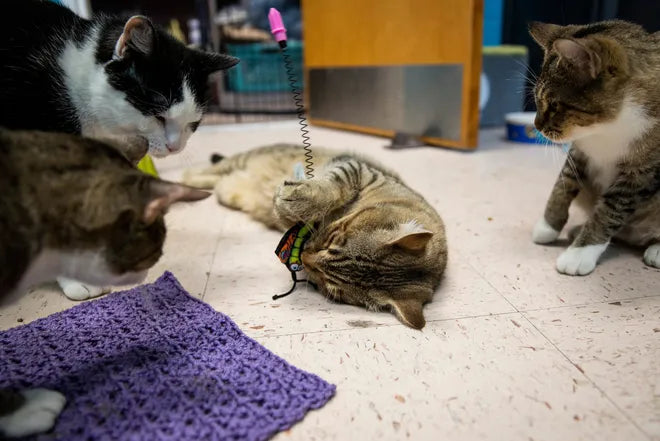What is catnip, and how does it work? Why cats go wild for the treat
What is catnip, and how does it work? Why cats go wild for the treat
Couldn't load pickup availability
If you're a cat lover, you know that your furry friends can go absolutely wild for a sprinkling of catnip, the green herb that can be found in many cat toys or even grown in your own garden.
Once a cat gets a whiff, they'll rub their faces against it, roll around with it, meow or even appear to be – well – zonked out.
"It's quite amusing to us as humans," said Dr. Kate Anderson, a veterinary behaviorist and assistant clinical professor at Cornell University's Duffield Institute for Animal Behavior. "The cats that respond have a pretty profound reaction to it."
There's a scientific reason for the feline reaction: Catnip contains the oil nepetalactone, which binds to the cat's olfactory receptors in the nose and throat and causes a euphoric reaction for cats. Some will become playful in response, while others might act calmer or sleepy. Others show no reaction at all.
Felines' sense of smell is way better than ours
Tossing around a toy isn't the only way to keep your cat entertained. Providing stimulation for a cat's sense of smell is a key component in making sure it's in a healthy environment, Anderson said. Catnip can be a fun way to do that.
Cats have way more powerful senses of smell than humans, she said. They have about 20 square centimeters of olfactory epithelium, the tissue in the nose that detects scent and sends that information to the brain, compared to about 2 to 4 square centimeters for humans.
Their response to smelling catnip, while still not perfectly understood by researchers, is believed to be like euphoria, Anderson said. It's a pleasant feeling of intense happiness for cats, which they might display by rubbing their faces and heads against the catnip, shaking their heads or drooling.
Crosswords Promo January 2025
Do cats get 'high' from catnip?
Cats aren't quite getting "high," Anderson said, though they might appear that way. Some research does suggest the essential oil in catnip that causes them to go wild for it does so by activating cats' opioid reward system, kind of like humans' opioid systems are activated by opiates, increasing beta endorphins or "feel-good chemicals" in the brain, Anderson said.
"It's not necessarily like a drug, the same level as taking a drug. It's an all-natural drug," she said, adding that humans can increase beta endorphins through activities like going for a run.
The best veterinarian hospitals? Vets can help USA TODAY rank top animal hospitals
And while there isn't really such a thing as "too much" exposure to catnip, cats do become desensitized to it, Anderson said. The euphoric effects of catnip wear off for most cats after about 10 to 15 minutes, according to the Cornell Feline Health Center. Cats will then be resistant to its effects for at least an hour, and if they're given catnip more than once a week or so, they can develop a kind of tolerance.
And, cat owners should note that while catnip is generally safe to ingest, it can cause gastrointestinal symptoms if a lot is consumed, Anderson said. To get that catnip frenzy, cats need only smell the catnip, but some cats will also chew catnip plants.
Not all cats react to the good stuff
Cats may display varying reactions to catnip – or none at all. A 2017 study on cats' reactions to different types of cat-stimulating plants found that about one in three cats had no reaction to catnip.
If your cat doesn't respond to catnip, you can try giving them another plant called silver vine, which operates similarly when cats smell it. In the study, published in the BMC Veterinary Research journal, 75% of cats that didn't respond to catnip did have a reaction to silver vine.
Also, young kittens under about 3 months old don't react to catnip.
But all cat species can be affected by it, even big cats, who react to it similarly to house cats. The London Zoo has sprinkled catnip around its lion enclosure to encourage its lions to move around.
Share

